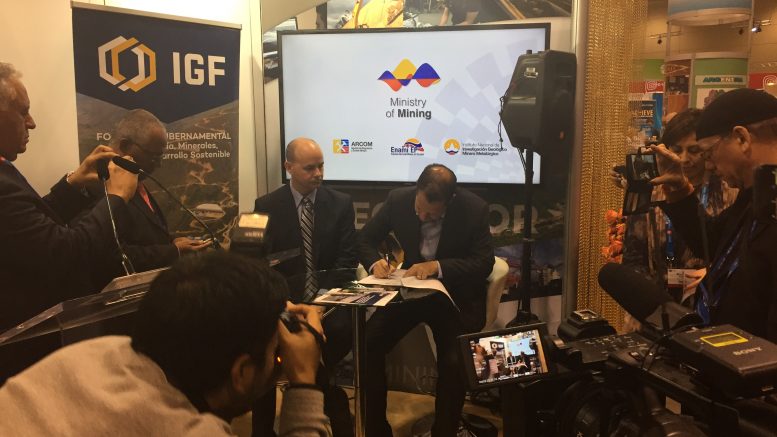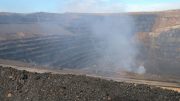Ecuador’s government expressed its commitment to mining by joining the Intergovernmental Forum on Mining, Minerals, Metals and Sustainable Development (IGF) at the recent Prospectors and Developers Association of Canada (PDAC) convention in Toronto.
“IGF is the only intergovernmental forum that promotes good practice, sustainable development, and quality production in the mining sector and globally for governments,” IGF director Greg Radford said during a March 7 press conference.
The IGF encourages good governance through its flagship mining policy framework (MPF). The MPF addresses six areas of mining policy and law: the legal and policy environment, environmental management, socioeconomic benefit optimization and financial management, as well as mine closure and artisanal and small-scale mining.

The camp at Lundin Gold’s Fruta del Norte gold project in Ecuador. Credit: Lundin Gold.
IGF’s members work together to share best practices, Radford continued, before welcoming the government of Ecuador as IGF’s 57th member.
“It’s really important for us to be part of this forum,” Javier Cordova, Ecuador’s Minister of Mining, said in an interview. Ecuador will contribute to the global dialogue on sustainable mining as well as learn from the experiences of the other 56 members, which include established mining countries Canada, the United Kingdom, Mexico, Argentina and South Africa.
Cordova, who a day earlier attended PDAC’s meeting of mining ministers, says the countries have similar concerns related to mining.
“The challenges that Canada, Sweden, Australia or Ecuador have are not very different,” Cordova said. “We are all concerned about the environment, water and communities. We all want mining to be developed in a responsible and sustainable way.”
Since Ecuador’s mining ministry formed in 2014, the country has improved its mining-related policies — particularly its tax laws.
“We understood a couple years ago that our legal and taxation conditions were not appropriate for the industry. So we weren’t attractive, even though we had the resources and the geologic potential,” Cordova said.
In early 2014, the ministry hired Wood Mackenzie consultants to propose changes to help draw in foreign investment.

A field crew collects samples at INV Metals’ Loma Larga gold project in Ecuador. Credit: INV Metals.
Ecuador has since lowered its tax burden to become more competitive. For example, the tax burden for a large-scale copper project dropped from 30% in 2014 to 23% after 2016, while for a large-scale gold project it went from 27% to 21% over the same period.
Ecuador also created other incentives, such as access to cheap electricity and labour, while reopening its mining cadaster in 2016.
To date, it has received 420 requests for new mining concessions from private companies and individuals around the world. It has already granted 160 concessions and expects to issue the rest in the coming months.
The underexplored country boasts several large projects, including Lundin Gold’s (TSX: LUG) Fruta del Norte gold deposit. Last December, Lundin signed an investment protection agreement and an exploitation agreement for the project. Fruta del Norte should see mine construction begin this year, followed by initial production in 2020.
Once Lundin starts building, Cordova says the international mining community will see the benefits of investing in Ecuador, creating a “better sense of trust in the country.”
He added that “our job is to create the conditions that the industry needs. As a country and as Ecuadorians — we don’t win anything if we don’t develop a project. To have the resources buried in the land is no good for anybody. For those mineral resources to be converted into wealth not only for the companies but for our people, we need companies to invest.”
Other Canadian juniors with projects in Ecuador include INV Metals (TSX: INV) and Dynasty Metals & Mining (TSX: DMM).
In 2016, Ecuador ranked 76th out of 104 jurisdictions surveyed on the Fraser Institute’s Investment Attractiveness Index, up from 92nd in 2015. But based on policy alone, which excludes the country’s mineral potential, Ecuador is one of the two Latin American countries, along with Venezuela, to remain in the bottom-10 jurisdictions.
Cordova acknowledges there is room to improve the country’s policies, and intends to keep working with the industry and make use of IGF’s member services. These services include in-country assessments, guidance documents, capacity building training on key mining and development issues, and technical assistance.
IGF was formed during the 2002 World Summit on Sustainable Development in Johannesburg, South Africa, where delegates outlined the difficulties and opportunities related to mining and sustainable development. It is a voluntary partnership that is open to any United Nations member.






Be the first to comment on "PDAC 2017: Ecuador joins IGF, lays out welcome mat for miners"